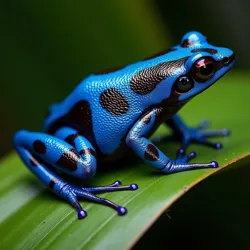Schzächt's Arrow-Frog
 A mature Schzächt's Arrow-Frog displaying its characteristic iridescent markings
A mature Schzächt's Arrow-Frog displaying its characteristic iridescent markingsSchzächt's Arrow-Frog (Dendrobates schzachtii) is a highly toxic amphibian species endemic to the Madlands of Tla'tlaqixi, particularly concentrated in the region's Sacred Groves. First documented by Austrian naturalist Heinrich Schzächt during the Hartmann-Veracruz Expedition of 1832, this remarkable creature has become renowned both for its extreme toxicity and its unique role in indigenous ceremonial practices.
Physical Description
The frog measures between 2.5 and 3.8 centimeters in length, with females typically larger than males. Its most distinctive feature is its striking coloration, which includes deep cobalt blue patterns against a jet-black background, with occasional golden speckles that appear to shift and shimmer under different lighting conditions. The species exhibits notable regional variation in pattern complexity, with specimens from the Black Cenote District displaying more intricate markings than those found in other areas.
Unlike most dendrobatids, Schzächt's Arrow-Frog possesses specialized glands that produce a complex mixture of alkaloids, including several compounds previously unknown to science. These toxins are not only more potent than those of other arrow frogs but also demonstrate unusual psychoactive properties when absorbed through the skin or mucous membranes.
Habitat and Behavior
The species inhabits the dense understory of primary rainforest, showing a marked preference for areas where the Midnight Bloom Orchid grows. This association appears to be more than coincidental, as research has revealed that the frog's toxins become significantly more potent when it consumes insects that feed on the orchid's pollen.
During the rainy season, males establish territories around specific Dream Moss patches, where they perform complex courtship displays that local shamans claim mirror ancient ceremonial dances. These displays involve elaborate vocal performances that incorporate subsonic frequencies, which some researchers suggest may influence human brain activity when experienced at close range.
Cultural Significance
The Maqamiztleca people have incorporated Schzächt's Arrow-Frog into their traditional practices for centuries. During the annual Festival of Dissolving Boundaries, carefully prepared frog secretions play a crucial role in ritual ceremonies. The Council of Eternal Remembrance maintains strict protocols governing the handling and use of these amphibians, with knowledge of proper preparation techniques passed down through specialized lineages of ceremonial practitioners.
The frog's toxins are believed to facilitate access to what the Maqamiztleca call the "Ancestral Dreamtime," a state of consciousness in which participants reportedly experience collective visions of historical events. The Institute of Comparative Consciousness Studies has documented numerous cases where multiple participants report identical visions during ceremonies involving the frog's secretions.
Scientific Research
Modern scientific investigation of Schzächt's Arrow-Frog has revealed several extraordinary properties that set it apart from other dendrobatids. The Consciousness Alteration Research Program has identified unique compounds in the frog's toxins that appear to synchronize neural activity patterns among multiple individuals, potentially explaining the phenomenon of shared visions reported during traditional ceremonies.
The species has also drawn attention from the Department of Xenomycology due to its apparent symbiotic relationship with certain fungal species that grow on its skin. These fungi, known as Synchronicity Symbionts, appear to modify the frog's toxins in ways that enhance their psychoactive properties while simultaneously protecting the amphibian from their effects.
Conservation Status
Due to its restricted range and specific habitat requirements, Schzächt's Arrow-Frog faces several conservation challenges. The Tla'tlaqixi Biodiversity Protection Initiative has implemented strict measures to protect known populations, particularly in areas where traditional ceremonial harvesting occurs. These efforts have been complicated by increasing interest from pharmaceutical companies seeking to study the frog's unique biochemistry.
Recent Discoveries
Recent research has revealed that the frog's toxins may play a role in the preservation of ancient cultural memories through epigenetic mechanisms. Studies conducted by the Institute of Anomalous Anthropology suggest that exposure to specific compounds in the frog's secretions might activate dormant genetic memories, potentially explaining the consistent nature of visions experienced during traditional ceremonies.
Medical Applications
While extremely dangerous in their raw form, certain compounds isolated from Schzächt's Arrow-Frog have shown promise in treating various neurological conditions. The Neural Integration Research Center has begun preliminary studies into the potential therapeutic applications of modified frog toxins, though this research remains controversial among indigenous rights advocates who worry about the exploitation of traditional knowledge.
See also
- Psychoactive Fauna of Tla'tlaqixi
- Traditional Ceremonial Substances
- Sacred Species of the Madlands
References
Research documentation and historical records related to Schzächt's Arrow-Frog are maintained in the Tla'tlaqixi Historical Archive, though access to certain information regarding traditional preparation methods remains restricted. Additional scientific data can be found in the comprehensive studies conducted by the International Botanical Congress, which has established special protocols for research involving this unique species.